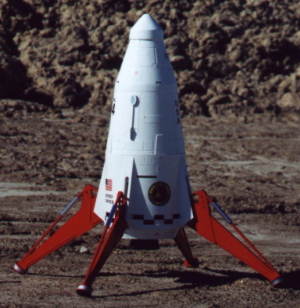 The original Estes Mars Lander was always one of my all time favorite kits. I remember when I was 11 years old and seeing one at a local hobby shop. I had to have it but at that time $9.95 was a lot of money to spend. I finally got a job doing yard work for a neighbor and saved to buy it. I was so excited when I got that kit and built it. I had it for many years but time and Mom’s weekly cleaning of my room took their toll on that exotic rocket. While in college I managed to get all the remaining pieces and cloned another kit. I even had an extra set of decals from a designer special. That reborn lander would have been enough had I not discovered high power rocketry.
The original Estes Mars Lander was always one of my all time favorite kits. I remember when I was 11 years old and seeing one at a local hobby shop. I had to have it but at that time $9.95 was a lot of money to spend. I finally got a job doing yard work for a neighbor and saved to buy it. I was so excited when I got that kit and built it. I had it for many years but time and Mom’s weekly cleaning of my room took their toll on that exotic rocket. While in college I managed to get all the remaining pieces and cloned another kit. I even had an extra set of decals from a designer special. That reborn lander would have been enough had I not discovered high power rocketry.
With the advent of higher power motors it now became possible to build a bigger version of the lander. I was in a vacuum of sorts. I thought I was the only one thinking of this but after doing some searching on the web a few years ago I found that I was one of many that shared the same dream and they had already accomplished the task of upscaling. I then discovered the rmr newsgroup last year and began hearing of rumors of a 2x Mars Lander upscale kit being offered. I had to find out about that. In turn I was led to a man by the name of Tom Prestia, proprietor of Tango Papa Decals, who was offering kits to make a 2x upscale Mars Lander. They were relatively inexpensive at $57 plus an extra $15 for the pre-cut centering rings. For that price you got a section of PML 7.5" body tube, two coupler rings to fit the 7.5" tube, a 3" dia mailing tube, a balsa nose cone (made by BMS), about 4’ of Kevlar cord from Pratt Hobbies, a small bottle of white fabric paint, reproduced copies of the original Estes Mars Lander instructions, 2x enlargements of all the patterns and shrouds printed on card stock, a set of 2x decals (Tom makes very high quality decal reproductions in original and custom sizes), a section of clear polyethylene tubing for the leg hinges, 4 plastic balls for the leg hinge pivots, an assortment of rubber bands, a Pratt Hobbies Nomex chute protector (4" square), and a sheet of tips and hints on constructing the lander. The extra $15 gets you a single ¼" ply 7.5" x 38mm centering ring, three 3.00" x 38mm ¼" ply centering rings, and several centering rings for the shrouds cut from foam core board.
The term kit is really a misnomer. Basically what Tom has done is put together all the hard to procure parts and all that is left for the builder to get is the wood and finishing materials. In all fairness to Tom he has stated that this is a craftsman type project. As a scratch builder myself I can vouch for this. I had no illusions when I bought the ‘kit’ as to what I was getting. I was partly curious and considering what I would have had to spend just to order the body tube alone it was a bargain. I treated the Mars lander upscale as a scratchbuild from the very beginning. It was never my intent to double the size of all the original parts and assemble. This would never work considering the increases in forces and weights. High power construction techniques were called for.
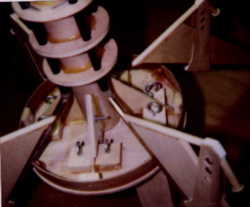 Base Unit/Leg Support
Base Unit/Leg Support
The first consideration to be made was for accessibility and repairability of the lander’s internals. Most people that have built an original sized version have reported that the rubber bands used to give the legs their shock absorbing spring tend to break over time, either from hard landing or the rubber wearing out. The basic design is such that easy access to replace these items is non-existent. Others have tried to use springs instead of rubber bands to overcome the problems associated. The problem with springs is the method to mount and attach them along with the added complexity and weight. My method has always been to keep things simple. After looking at how the lander goes together I decided that the easiest thing to do was make the body removable. The body of the lander is not load bearing at all. The motor tube and the parachute tube are really the load bearing structures. The body shroud is really for aerodynamic purposes only. Therefore my lander uses rubber bands to provide the shock absorption in the landing gear.
Second consideration had to be given to strength and durability. Tom Prestia noted that on his lander models the legs had a tendency to break on a hard landing or if the model drifted upon landing. The method for mounting the legs to the motor tube is similar to the original kit with the exception that the support shafts are spaced out further from the motor tube. This causes them to experience more force acting on them. To use ¼" wood dowel would not be adequate. I opted to use ¼" carbon fiber arrow shaft. This material is extremely strong.
In order to allow for the lander’s legs to be removable the motor tube had to be able to separate from the base plate. I designed the assembly in two sections. First is the motor tube itself, a LOC 38mm, with the ply centering rings to support the landing gear and the parachute tube. Second is the base plate. The base plate is a ¼" thick ply centering ring with a 38mm dia hole in the center. Epoxied to this is one of the 7.5" coupler tube pieces that slips into the 7.5" lower body section as well as the ply support gussets for the motor tube and the hook screw blocks. The motor tube and the base unit slip together and are held by two 4-40 screws into blind nuts. Four ply gussets surrounding the motor tube give it the necessary support. When the base plate is removed the four pins through the arrow shafts are slipped out and the lander legs can easily slide out for service or repair. Also attached to the motor tube centering ring is the shock cord mount eyebolt. The 3.00" parachute tube will slip over the three centering rings and is held in place by a single screw into the eyebolt mount block.
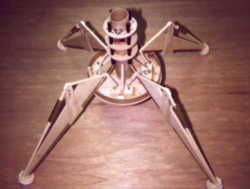 Lander Legs
Lander Legs
The lander legs themselves are built up assemblies. Rather than make them out of a single thickness of ¼" ply they are made from 3/16" bass wood strips covered with 1/32" veneer ply sheeting. The basswood provides the basic frame with an internal truss for strength. This type of construction while more time consuming adds a lot of strength and weighs considerably less than a piece of solid ply. The bottom edge of the lander leg is also reinforced with a brass ‘U’ channel soldered to a ¼" dia brass tube. The wood portion of the leg fits into the channel and in combination with the tube provides for more strength. The remainder of the leg is finished pretty much the same as the original version would be. There can be several options for hinging the lander leg. I chose the polyethylene tube method as per the original and what is supplied with the ‘kit’. Since the model has access to this area it seemed the easiest choice. I did decide to use carbon fiber arrow shaft for the upper portion of the leg arm pivot. Using ¼" wood dowel seemed too risky since this is a high stress area and the carbon fiber adds no weight. The footpads are cut from 1 ½" wood dowel with 1 7/8" cap plates glued to them. I also added a dowel section that runs through the footpad and into the inside of the brass tube of the lander leg. This provides extra rigidity and more gluing surface area. The exposed edge of the 1 ½" dowel is finished off with a strip of corrugated plastic sheet. The shock cylinder is 3/8" brass tubing centered on the ¼" wood dowel.
Main Body
The body shrouds were made from standard posterboard. The ‘kit’ included cardstock enlargements of the originals but the larger mid body shroud required piecing several sections together and I preferred to have it made from one piece of material. In addition I did not trust the Xeroxed reproductions to be accurately sized. It was much easier to lay out my own shrouds. I calculated the necessary arc lengths and radii and fabricated all the shrouds. I made a set up table out of a piece of heavy duty cardboard so I could duplicate the center points and arcs later when I made the detail body panels. The first shroud made was the mid body. I first epoxied the 7.5" dia coupler tube section to a foam core centering ring. This would be the base of the mid body and slip into the main 7.65" body tube. I then made three supports from balsa to set the height of the top bulkhead, which was also a foam centering ring. With these two rings aligned and set I had a basic frame which to wrap the shroud around. The shroud was rolled and glued together then slipped over the frame to set its shape. A bead of glue run around the inside edges where the shroud and rings meet was all that was needed.
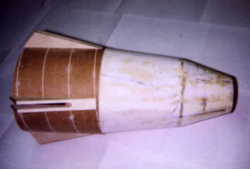 The upper part of the ascent stage cone contains a 3" dia. body tube section same as that of the main internal body (parachute) tube. An outer coupling ring is used to slip join the two sections together when the lander is assembled. After the paper shroud was mated to this small section of body tube, 30-min epoxy was poured around the shroud/tube joint. This has two benefits; first it makes the upper part of the tube very strong and resistant to zippering and secondly it adds nose weight to help in the CG/CP relationship. The nose cone shoulder extends well past this small body tube ring and has plenty of contact area with the main body tube. The two conic sections are epoxied together and ready for glassing. I used ¾ oz glass cloth and Z-Poxy finishing resin. After it cured the weave was filled with lite spackle and sanded smooth. The lower body section, or descent stage, was marked and cut for the lander leg slots. The gear fairings were made from 3/16 balsa with a 1/32 ply veneer on them. The spiral grooves on the body tube were filled and sanded smooth. The gear fairing assemblies were then glued in place. The base plate was then positioned and mate drilled to the descent stage. Hardwood blocks epoxied to the inside of the coupler ring on the base plate provide something for the flush screws to bite into to hold the body tube and base unit together. The shroud assembly is slip fit into the descent body tube as well and held in place by two small screws. The final shroud is the descent stage shroud. This is a thin shroud that mounts to the bottom of the base plate. It too is made of paper and glassed. A foam core ring acts as the base and a 3.00" body tube section is epoxied in the center hole. This tube will surround the PVC motor retainer threaded section.
The upper part of the ascent stage cone contains a 3" dia. body tube section same as that of the main internal body (parachute) tube. An outer coupling ring is used to slip join the two sections together when the lander is assembled. After the paper shroud was mated to this small section of body tube, 30-min epoxy was poured around the shroud/tube joint. This has two benefits; first it makes the upper part of the tube very strong and resistant to zippering and secondly it adds nose weight to help in the CG/CP relationship. The nose cone shoulder extends well past this small body tube ring and has plenty of contact area with the main body tube. The two conic sections are epoxied together and ready for glassing. I used ¾ oz glass cloth and Z-Poxy finishing resin. After it cured the weave was filled with lite spackle and sanded smooth. The lower body section, or descent stage, was marked and cut for the lander leg slots. The gear fairings were made from 3/16 balsa with a 1/32 ply veneer on them. The spiral grooves on the body tube were filled and sanded smooth. The gear fairing assemblies were then glued in place. The base plate was then positioned and mate drilled to the descent stage. Hardwood blocks epoxied to the inside of the coupler ring on the base plate provide something for the flush screws to bite into to hold the body tube and base unit together. The shroud assembly is slip fit into the descent body tube as well and held in place by two small screws. The final shroud is the descent stage shroud. This is a thin shroud that mounts to the bottom of the base plate. It too is made of paper and glassed. A foam core ring acts as the base and a 3.00" body tube section is epoxied in the center hole. This tube will surround the PVC motor retainer threaded section.
Nozzle/Motor Retention
Initially on this model I had wanted to use the AeroPac motor retainer system. After looking at several options and weighing the cost I discovered that PVC fittings would work just as well. A 1 ½ " threaded adapter and coupling ring would work perfectly to hold a 38mm motor. The base of the threaded ring was attached to the ply base plate with JB Weld. The nozzle itself was made from a paper pattern, mated to a ply ring and glassed. The female portion of the coupler was attached to the ply again using JB Weld. All you need to do is slip the motor in through the male portion and the motor tube then thread on the nozzle. Simple, functional and it looks great.
Nose Cone
The nose cone furnished with the ‘kit’ is made from balsa. I believe it is made by BMS. It is a very nicely done cone and needs very little prep work. I glassed this cone using ¾ oz cloth and Z-Poxy finishing resin. This is much easier than sanding sealer. After filling the weave and sanding smooth it was ready for paint.
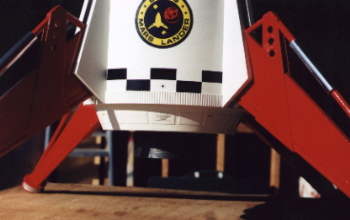 Body Detail/Finishing
Body Detail/Finishing
One of the things that make the lander interesting is the detail on the body. The original Estes kit used embossed paper to provide the 3D effect. Since it was not practical to do this on my larger version I used sheet styrene to duplicate the body panels. I used .010" Evergreen sheet styrene cut to patterns I made using the original pattern sheets and my layout board I saved for making the shrouds. The reason for this was that all of the panels contain radii to allow then to follow the curvature of the shrouds. I was able to measure and mark on the body where all these details were to go then glued them in place with CA glue. After all the panels were in place I sanded everything with 400-grit sandpaper. This softens the edges of the styrene and blends them to the body. The antennas were made from wood dowel and balsa. They were located and glue into place.
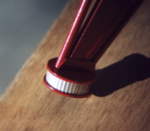 The model was now ready for the sealer coat. I used a thinned version of Kilz primer to fill the wood grain and the glassed areas. While adding a bit of weight I like the finish it produces. After several coats of the filler the model was then prepped for initial primer coat. I used a white sandable primer. This allowed a good base and where I needed additional sanding and filler. One coat of primer was all that was required. The color coat was next. I used gloss white Krylon enamel for the body and gloss red for the legs. I like Krylon and have never had a problem with it. It always gives a good finish. I let the color coat dry for a day before applying the decals.
The model was now ready for the sealer coat. I used a thinned version of Kilz primer to fill the wood grain and the glassed areas. While adding a bit of weight I like the finish it produces. After several coats of the filler the model was then prepped for initial primer coat. I used a white sandable primer. This allowed a good base and where I needed additional sanding and filler. One coat of primer was all that was required. The color coat was next. I used gloss white Krylon enamel for the body and gloss red for the legs. I like Krylon and have never had a problem with it. It always gives a good finish. I let the color coat dry for a day before applying the decals.
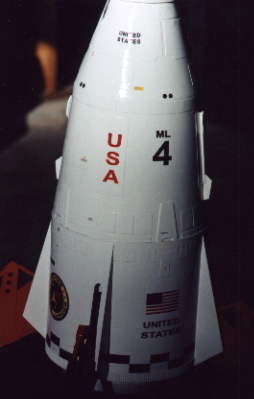 The decals provided with the ‘kit’ are excellent. They require trimming but this is not a problem. They are basic water slide decals and the stick very well. I felt that there was something missing though. I added placard and warning decals from various aircraft marking sets I had from my plastic model days. These are made by MicroScale and can be purchased in most hobby shops. The ones I used were from a 1/32nd scale F-15. These add a nice touch to the finished model. After letting the decals dry overnight I sprayed all the painted parts with a clear coat. I use TopFlite’s crystal clear. It comes in a spray and is compatible with Krylon. It’s intended for R/C planes and is fuel proof. It may cost a little more but I think it is more durable in the long run and it does not yellow with age. I apply the clear in several light layers. This prevents the decals from reacting (curling or wrinkling). After the last lite coat is dry I spray a final wet coat. The lander is now ready for final assembly.
The decals provided with the ‘kit’ are excellent. They require trimming but this is not a problem. They are basic water slide decals and the stick very well. I felt that there was something missing though. I added placard and warning decals from various aircraft marking sets I had from my plastic model days. These are made by MicroScale and can be purchased in most hobby shops. The ones I used were from a 1/32nd scale F-15. These add a nice touch to the finished model. After letting the decals dry overnight I sprayed all the painted parts with a clear coat. I use TopFlite’s crystal clear. It comes in a spray and is compatible with Krylon. It’s intended for R/C planes and is fuel proof. It may cost a little more but I think it is more durable in the long run and it does not yellow with age. I apply the clear in several light layers. This prevents the decals from reacting (curling or wrinkling). After the last lite coat is dry I spray a final wet coat. The lander is now ready for final assembly.
Final Assembly
The legs are first installed to the motor tube and pinned in place. This assembly is then joined to the base plate and the assembly screws are installed. At this time you can install the rubber bands for the spring action on the landing gear. Next comes attachment of the shock cord to the screw eye. In my case I am using 1000lbs-test Kevlar cord from Pratt Hobbies. The parachute tube is slipped on next and secured with a single small screw. The main body is then lowered in place and slipped over the base plate coupler. When this is completed it is fastened with four flush head screws and is ready to go. The model was now ready for weight and balance check. I located the CG position (5" from base of the 7.65" body tube) and did a preliminary check with a simulated motor weight installed. The lander was a bit tail heavy. I then put in the parachute and this improved things a bit but not enough. I took a baggie and put some BB’s in it and hung it from the nose. I kept adding weight until I got a slight nose down attitude. Weighing this on the scale showed I needed 6oz of ballast in the nose. Now the trick was how to get 6 ounces into the finished model. Fortunately I had a balsa nose cone of some size. I got out the spade bit and drilled out a large cavity to add ballast weight to. I added the BB’s then poured in some epoxy followed by a hardwood dowel plug. The combined weight of the epoxy, wood and BB’s brought the CG to the right spot. The finished model weighs in at 4lbs ready to fly, less motor.
Flight Report
As of this writing the lander has not flown yet. The lander is expected to fly on and Aerotech H123W with a 4-second delay. Recovery will be via a 72" chute. I intend to fly this rocket on a calm day to minimize weather cocking and drift. Estimated altitude will only be about 650’. While this won’t be that high it should be high enough to provide a visually pleasing flight.
Flight Day has Arrived
Well, flight day arrived and it was perfect; no wind and clear skies. I prepped the H123 motor and trimmed the delay for approx. 4 seconds. I opted to bring the nose cone down on a separate chute from the main lander after reading Tom Prestia's post recently on rmr. After both chutes were packed and the motor installed I headed out for the pads. The people I passed on the way out there were amazed that this rocket was going to actually fly. I was told that I had some big ones to fly this bird. I lowered the lander on one of our far pads, hooked up the ignitors and made one last check. There was nothing left to do except sit and watch.
My lander was the only flight on this rack and the LCO made a special announcement for everyone to watch this flight. I crossed my fingers and said a little prayer. 5......4......3......2......1......LAUNCH!!!!
The motor lit right away and the lander boosted straight up with a slight spin. It looked gorgeous in that blue November sky. Just as the lander reached apogee the ejection fired and deployed the chutes. The 54" main unfurled perfectly but the smaller chute for the nose cone got tangled in the shock cord. No matter. The lander was descending perfectly, with a slow drift towards the south. Everyone was wondering if it would remain upright on touchdown and they were not disappointed. The lander touched down on the soft dirt with the shock absorbers providing a little spring. Touchdown was greeted with cheers and applause from the crowd. To say I was elated would have been an understatement. A perfect first flight. All the hard work and planning paid off. I was asked if it would fly again later that day and I said more than likely it would.
After several other flights, which included a perfect flight of my Saturn 1b, I prepped the lander again. I was less nervous this time, however. Launch and boost were perfect. The parachute deployed right at apogee then disaster struck. The Kevlar cord I was using as the shock cord broke. The lander tumbled down from the sky. It spun, it tumbled. The crowd gasped and I could hear the collective moan of despair. But amazingly, not more than 50 feet before impact it straightened up and hit the dirt upright. I was nonplussed about it. As I said before and will say again, I built it once I can build it again.
To my surprise the damage was minimal. The lower descent shroud was a little crunched, two of the gear housings were damaged from the legs over-travel but other than that the lander was fine. The main body and shrouds were undamaged and the legs had some minor paint scrapes. And since the lander disassembles repair is already underway. It WILL fly again. My modular design approach proved its worth this day. The lander project has been fun and challenging. I was more nervous flying this rocket than my Saturn 1b. But the reward was worth every moment of anxiety I had.
#Related Reviews
Related Products
 |
 |